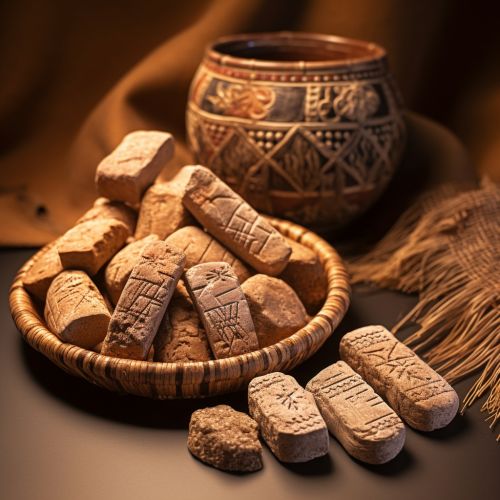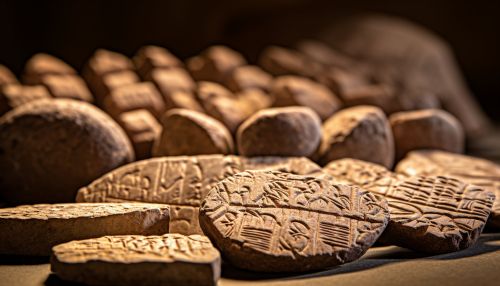Assyriology
Introduction
Assyriology is the study of the cultures and histories of ancient Mesopotamian civilizations using the Akkadian language and cuneiform script. The field encompasses the study of the Akkadian-speaking Assyrians and Babylonians, as well as their Sumerian predecessors. Assyriology covers a timespan from the 25th century BCE to the end of the 1st century CE, and includes the study of art, law, mythology, science, and geography of these civilizations.


History of Assyriology
The birth of Assyriology began with the discovery of the Rosetta Stone in 1799, which led to the decipherment of Egyptian hieroglyphs. This discovery sparked interest in deciphering other ancient scripts, including cuneiform. The first major breakthrough in the field came with the translation of the Behistun Inscription by Sir Henry Rawlinson in the mid-19th century. This trilingual inscription, written in Old Persian, Elamite, and Babylonian (a form of Akkadian), provided the key to deciphering cuneiform script.
Assyriology as a discipline became more formalized in the late 19th and early 20th centuries, with the establishment of dedicated departments in universities such as Oxford, Paris, and Berlin. The field has continued to grow and evolve, with new discoveries and technological advancements, such as digital humanities and satellite imagery, providing new insights into the ancient Near East.
Akkadian Language and Cuneiform Script
The Akkadian language, named after the city of Akkad, was a Semitic language spoken in ancient Mesopotamia. It was written in the cuneiform script, one of the earliest systems of writing. Cuneiform, which means 'wedge-shaped', was used for over 3000 years and adapted for writing several languages, including Sumerian, Akkadian, Eblaite, Elamite, Hittite, and Urartian.
The script consists of a combination of wedge-shaped marks made on clay tablets with a reed stylus. These marks represent syllables, logograms (words represented by a single symbol), or determinatives (symbols that provide context to the following word). The complexity of the script, with hundreds of signs and multiple possible readings for each sign, makes cuneiform difficult to decipher and translate.
Mesopotamian Civilizations
Assyriology encompasses the study of several ancient Mesopotamian civilizations, including the Sumerians, Akkadians, Babylonians, and Assyrians.
Sumerians
The Sumerians are considered the creators of civilization as we know it. They invented writing, the wheel, the plow, and the concept of the city-state. They also developed a complex religious system with a pantheon of gods and goddesses, elaborate myths, and a belief in the afterlife.
Akkadians
The Akkadians, under the rule of Sargon of Akkad, created the world's first empire. They adopted and adapted many aspects of Sumerian culture, including their writing system, but spoke a Semitic language, now known as Akkadian.
Babylonians
The Babylonians are perhaps best known for the law code of Hammurabi, one of the oldest deciphered writings of significant length in the world. They also made significant advancements in mathematics and astronomy.
Assyrians
The Assyrians were renowned for their military prowess and architectural achievements, including the construction of vast palaces and aqueducts. They also developed a library at Nineveh, which included thousands of cuneiform tablets covering a wide range of topics.
Methodology
Assyriologists use a variety of methods to study the ancient Near East. These include philology, the study of ancient texts; archaeology, the excavation and analysis of ancient sites; and the study of art history and iconography.
Philology involves the translation and interpretation of cuneiform texts, which provide a wealth of information about Mesopotamian society, including economic transactions, legal codes, medical texts, literary works, and royal inscriptions.
Archaeology provides insights into the material culture of Mesopotamian civilizations, including architecture, art, tools, and everyday objects. Excavations at sites such as Ur, Uruk, and Nineveh have yielded important finds that have greatly enhanced our understanding of these ancient societies.
The study of art history and iconography involves the analysis of Mesopotamian art and imagery, which can provide insights into religious beliefs, social hierarchy, and cultural interactions.
Current Research and Future Directions
Current research in Assyriology is diverse and interdisciplinary, encompassing areas such as social and economic history, religious studies, gender studies, and digital humanities. Recent discoveries, such as the archive of clay tablets at Kanesh (modern Kültepe) in Turkey, continue to provide new material for study.
The future of Assyriology looks promising, with new technologies providing innovative ways to study and interpret the ancient Near East. Digital humanities, for example, are transforming the field by enabling the creation of databases of cuneiform texts, 3D reconstructions of ancient sites, and the digital mapping of archaeological landscapes.
